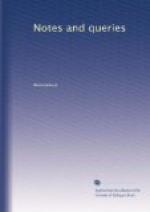I have already promised, for fuller details of the
evidence I have collected; but its leading results,
as affecting the origin of this device, may be stated
as follows:—It is ascertained that the Collar
of Esses was given by Henry, Earl of Derby, afterwards
King Henry IV., during the life-time of his father,
John of Ghent, Duke of Lancaster. It also appears
that the Duke of Lancaster himself gave a collar,
which was worn in compliment to him by his nephew
King Richard II. In a window of old St. Paul’s,
near the duke’s monument, his arms were in painted
glass, accompanied with the Collar of Esses; which
is presumptive proof that his collar was the same as
that of his son, the Earl of Derby. If, then,
the Collar of Esses was first given by this mighty
duke, what would be
his meaning in the device?
My conjecture is, that it was the initial of the title
of that high office which, united to his vast estates,
was a main source of his weight and influence in the
country,—the office of Steward of England.
This, I admit, is a derivation less captivating in
idea than another that has been suggested,
viz.
that S was the initial of
Souveraine which is
known to have been a motto subsequently used by Henry
IV., and which might be supposed to foreshadow the
ambition with which the House of Lancaster affected
the crown. But the objection to this is, that
the device is traced back earlier than the Lancastrian
usurpation can be supposed to have been in contemplation.
It might still be the initial of
Souveraine,
if John of Ghent adopted it in allusion to his kingdom
of Castille: but, because he is supposed to have
used it, and his son the Earl of Derby certainly used
it, after the sovereignty of Castille had been finally
relinquished, but also before either he or his son
can be supposed to have aimed at the sovereignty of
their own country, therefore it is that, in the absence
of any positive authority, I adhere at present to
the opinion that the letter S was the initial of Seneschallus
or Steward.
JOHN GOUGH NICHOLS.
P.S.—Allow me to put a Query to the antiquaries
of Scotland. Can any of them help me to the authority
from which Nich. Upton derived his livery collar
of the King of Scotland “de gormettis fremalibus
equorum?”—J.G.N.
Collar of SS (Vol. ii., pp. 89. 194. 248. 280.).—I
am surprised that any doubt should have arisen about
this term, which has evidently no spiritual
or literary derivation from the initial letters
of Sovereign, Sanctus, Seneschallus,
or any similar word. It is (as MR. ELLACOMBE
hints, p. 248.) purely descriptive of the mechanical
mode of forming the chain, not by round or closed
links, but by hooks alternately deflected into the
shape of esses; thus, [Illustration: 3
sideways capital letter S’s]. Whether chains
so made (being more susceptible of ornament than other
forms of links) may not have been in special use for
particular {331} purposes, I will not say; but I have
no doubt that the name means no more than that
the links were in the shape of the letter S.




